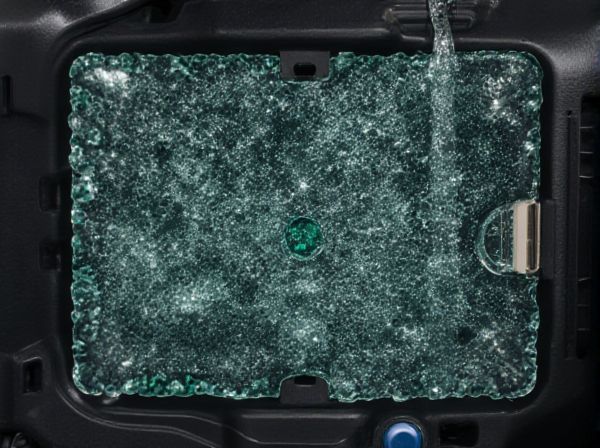
Photo illustration: Absorbed Glass Mat vs Flooded Cell
Absorbed Glass Mat (AGM) batteries provide better vibration resistance and faster charging compared to Flooded Cell batteries, making them ideal for high-performance vehicles and applications requiring maintenance-free power sources. Flooded Cell batteries are typically more affordable and easier to recycle but require regular water maintenance to prevent damage and ensure longevity. Your choice should depend on whether you prioritize maintenance convenience or upfront cost and environmental considerations.
Table of Comparison
| Feature | Absorbed Glass Mat (AGM) | Flooded Cell |
|---|---|---|
| Design | Sealed, valve-regulated lead-acid battery with glass mat separators | Open cell design with liquid electrolyte visible |
| Maintenance | Maintenance-free, no water refilling required | Requires regular water topping |
| Durability | Resistant to vibration and shock, suitable for extreme conditions | Less resistant, exposed to spills and corrosion |
| Charging Efficiency | Faster charging, lower self-discharge rate | Slower charging, higher self-discharge |
| Cost | Higher initial cost | Lower upfront cost |
| Application | Optimal for modern vehicles with start-stop systems and high electrical demands | Best suited for conventional vehicles and stationary use |
| Lifespan | Longer lifespan, typically 4-7 years | Shorter lifespan, typically 3-5 years |
Introduction to AGM and Flooded Cell Batteries
Absorbed Glass Mat (AGM) batteries utilize a fiberglass mat separator to hold electrolyte in place, providing spill-proof, maintenance-free operation and superior vibration resistance, making them ideal for high-performance and off-grid applications. Flooded Cell batteries contain liquid electrolyte that freely flows over the plates, requiring regular maintenance like water refilling and offering lower upfront cost but reduced lifespan and sensitivity to orientation. Understanding the distinct construction and maintenance needs of AGM and Flooded Cell batteries is crucial for selecting the optimal energy storage solution for automotive, marine, or renewable energy systems.
Key Differences Between AGM and Flooded Cell
Absorbed Glass Mat (AGM) batteries use a fiberglass mat to hold the electrolyte, making them spill-proof and maintenance-free, while Flooded Cell batteries contain liquid electrolyte that requires regular topping up and can spill if tipped. AGM batteries offer superior vibration resistance and faster recharge times, whereas Flooded Cell batteries generally have a lower upfront cost and longer availability for deep cycling applications. Temperature sensitivity and self-discharge rates are lower in AGM batteries, optimizing their lifespan and performance in diverse conditions compared to traditional Flooded Cell designs.
Construction and Design Features
Absorbed Glass Mat (AGM) batteries utilize a fiberglass mat separator that absorbs electrolyte, creating a spill-proof and vibration-resistant design ideal for high-performance applications. Flooded cell batteries feature free-flowing liquid electrolyte between lead plates, requiring ventilation and regular maintenance to prevent electrolyte stratification and corrosion. AGM's sealed construction enhances safety and durability, while flooded cells offer simpler design and cost-effectiveness with periodic water replenishment.
Performance and Efficiency Comparison
Absorbed Glass Mat (AGM) batteries deliver higher efficiency with faster recharge times and lower internal resistance compared to Flooded Cell batteries, leading to enhanced performance in high-demand applications. AGM batteries offer better vibration resistance and longer cycle life, resulting in superior durability and energy retention under load. Flooded Cell batteries, while typically less expensive, require regular maintenance and have lower efficiency due to electrolyte stratification and higher self-discharge rates.
Maintenance Requirements
Absorbed Glass Mat (AGM) batteries require minimal maintenance due to their sealed design, which prevents electrolyte evaporation and eliminates the need for water refilling. Flooded Cell batteries demand regular maintenance, including checking electrolyte levels and topping off with distilled water to prevent damage and ensure optimal performance. Proper maintenance of flooded cells is critical to avoid sulfation and extend battery lifespan.
Lifespan and Durability Factors
Absorbed Glass Mat (AGM) batteries generally offer a longer lifespan and superior durability compared to Flooded Cell batteries due to their sealed design and resistance to vibration and temperature extremes. Flooded Cell batteries require regular maintenance and are more prone to sulfation and corrosion, which can shorten their service life. AGM technology enhances cycle life performance and provides better deep discharge recovery, making them more reliable in demanding applications.
Safety and Risk Considerations
Absorbed Glass Mat (AGM) batteries offer enhanced safety due to their sealed, spill-proof design, reducing risks of acid leaks and fire hazards compared to Flooded Cell batteries. Flooded Cell batteries require regular maintenance and ventilation to prevent hydrogen gas buildup, which poses explosion risks in enclosed spaces. AGM batteries exhibit superior resistance to vibration and impact, making them a safer choice for high-risk environments where battery damage could lead to hazardous conditions.
Cost and Value Analysis
Absorbed Glass Mat (AGM) batteries typically have a higher upfront cost compared to Flooded Cell batteries but offer greater value through longer lifespan, lower maintenance, and enhanced performance in deep cycling applications. Flooded Cell batteries, while more affordable initially, require regular maintenance and have a shorter service life, which can increase long-term costs. Evaluating total cost of ownership, AGM batteries provide better cost-efficiency for applications demanding durability and reliability despite their premium price.
Ideal Applications for Each Battery Type
Absorbed Glass Mat (AGM) batteries excel in applications requiring maintenance-free, vibration-resistant power sources, making them ideal for motorcycles, off-road vehicles, and marine use. Flooded Cell batteries are best suited for stationary applications where regular maintenance is feasible, such as backup power systems, solar energy storage, and automotive starting batteries. Understanding the demand for cycle life and environmental sealing helps determine the optimal battery type for each application.
Choosing the Right Battery for Your Needs
Absorbed Glass Mat (AGM) batteries offer superior vibration resistance, faster charging, and maintenance-free operation, making them ideal for high-performance applications and vehicles with advanced electronics. Flooded Cell batteries provide cost-effective power with easy rechargeability and are best suited for traditional vehicles or those with simple electrical demands. Selecting the right battery depends on factors like budget, usage patterns, climate conditions, and the specific energy requirements of your equipment or vehicle.
 caratoz.com
caratoz.com